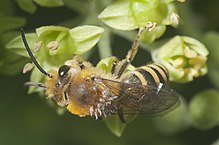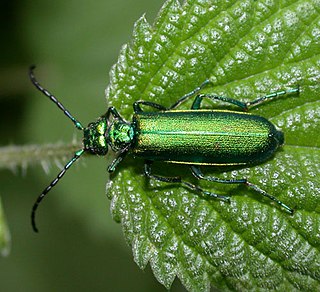
The Spanish fly is an aposematic emerald-green beetle in the blister beetle family (Meloidae). It is distributed across Eurasia.

Blister beetles are beetles of the family Meloidae, so called for their defensive secretion of a blistering agent, cantharidin. About 7,500 species are known worldwide. Many are conspicuous and some are aposematically colored, announcing their toxicity to would-be predators.

A planidium is a specialized form of insect larva seen in the first-instar of a few families of insects that have parasitoidal ways of life. They are usually flattened, highly sclerotized (hardened), and quite mobile. The function of the planidial stage is to find a host on which the later larval instars may feed, generally until the insect pupates.

Arsenura armida, the giant silk moth, is a moth of the family Saturniidae. It is found mainly in South and Central America, from Mexico to Bolivia, and Ecuador to south-eastern Brazil. It was first described by Pieter Cramer in 1779.

Colletes hederae, the ivy bee, is a species of plasterer bee belonging to the family Colletidae subfamily Colletinae.
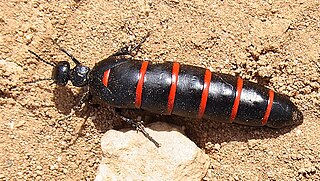
Berberomeloe majalis, the red-striped oil beetle, is an insect in the genus Berberomeloe, in the family of Blister Beetles. It is native to the western Mediterranean Basin.

Ceroctis capensis, or spotted blister beetle, is diurnal and endemic to Southern Africa occurring in diverse habitats, and belonging to the Meloidae or Blister beetle family. It secretes a toxic liquid from its leg joints when roughly handled, blistering human skin. This species somewhat resembles Mylabris oculata, a member of the same family.
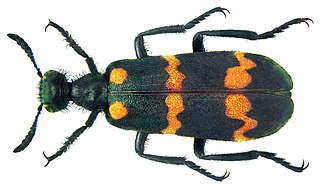
Hycleus pustulatus is a species of blister beetle found in India, Sri Lanka, China and Java.

Colletes halophilus, the sea aster mining bee, is a rare species of mining bee from the family Colletidae which is found around the margins of saltmarsh and other coastal habitats in south-eastern England and north-western Europe. It is threatened by rising sea levels and human development which reduce its food plant sea aster and destroy its nesting areas.

Colletes succinctus, the common colletes or heather colletes, is a species of Palearctic mining bee from the family Colletidae. It is part of the succinctus species group within the genus Colletes and is especially closely related to the ivy bee and the sea aster mining bee which are partially sympatric with C. succinctus but ecologically separate.
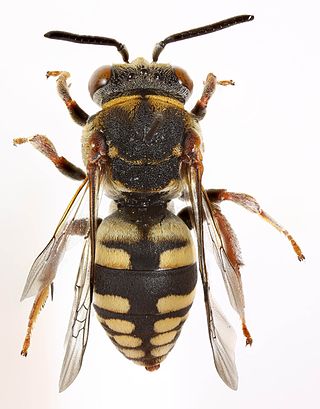
Epeolus cruciger, the red-thighed epeolus, is a species of cuckoo bee from the family Apidae. It is endemic to Europe, where its main host is the common colletes, although other species of Colletes mining bees have been recorded as hosts.

Hemileuca lucina, the New England buck moth, is a species of moth in the family Saturniidae. This moth species is only found in the New England region of the United States. Larvae in early stages mainly feed on broadleaf meadowsweet whereas larvae in later stages show variation in food sources such as blackberry and black cherry leaves. Larvae have a black body with orange/black spines on their back that are used to deter predators. Pupation occurs during the summer and adult moths come out around September.

Stenoria is a genus of blister beetles from the family Meloidae. Their larvae develop as parasitoids and brood parasites of the larvae of solitary bees of the families Megachilidae, Colletidae and Andrenidae. The genus contains more than 50 species They are found in the Palearctic from the Canary Islands east to Afghanistan, Tibet and north western China, and also in southern and eastern Africa.

Colletes validus, colloquially known as the blueberry cellophane bee, is a solitary, specialist bee in the family Colletidae. It is found primarily in eastern North America where it nests in sandy soils near ericaceous plants.
Meloe franciscanus is a species of blister beetle in the family Meloidae. It is found in the deserts of the southwestern United States. The larvae are parasites of bee larvae, eating them and consuming their provisions.

Tegrodera aloga, the iron cross blister beetle, is a species of blister beetle in the family Meloidae. It is found in Central America and North America.
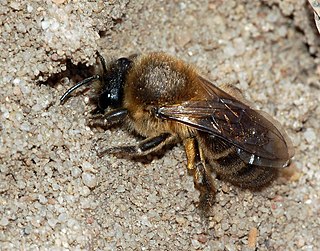
Colletes cunicularius, the vernal colletes or spring mining bee, is a species of solitary bee from the family Colletidae which is widespread in the Palearctic from Britain to the Pacific Ocean which nests in areas of open, sandy soil.
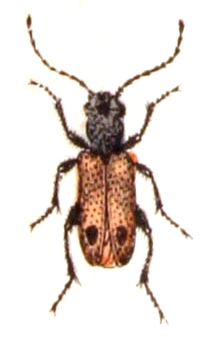
Apalus bimaculatus, the early blister beetle, is a species of blister beetle from the family Meloidae. It is the type species of the genus Apalus.

Sitaris muralis is a species of blister beetle in the subfamily Nemognathinae in the family Meloidae. It is found in Western Europe. It is a black beetle with buff-orange patches on the front of the elytra. It is a kleptoparasite of digger bees.

Meloetyphlus fuscatus, the blind blister beetle, is a species of blister beetle in the family Meloidae found in Central and South America. They are kleptoparasites of orchid bees and are entirely blind as adults. Unique among meloids, females do not lay their eggs near flowers, but rather within their hosts' nests.

